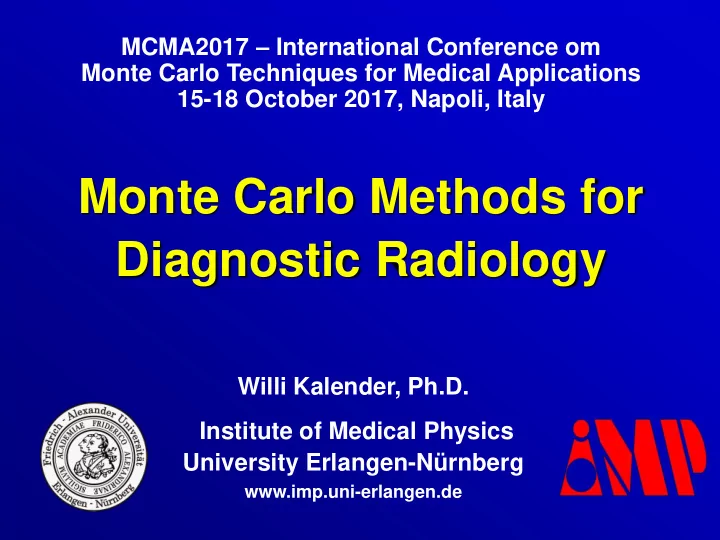

MCMA2017 – International Conference om Monte Carlo Techniques for Medical Applications 15-18 October 2017, Napoli, Italy Monte Carlo Methods for Diagnostic Radiology Willi Kalender, Ph.D. Institute of Medical Physics University Erlangen-Nürnberg www.imp.uni-erlangen.de
MCMA2017 is my first time at an MC conference, although I worked on MC topics from 1976-78. It led to my PhD degree at the Univ. of Wisconsin + 2 publications in the journal Phys. Med. Biol.
What can MC add to Diagnostic Radiology? - MC calculation of x-ray dose - support innovative technological approaches to reduce patient dose • Tube current modulation • Optimisation of X-ray spectra • Dose efficient image reconstruction • Detector systems with higher efficiency
In-plane or rotational TCM ( α -TCM) Attenuation (central ray) 3603 43 projection angle 0° 360° Tube current (for central ROI) max Attenuation for the central ray: in a.p. direction: 43 min projection angle 0° 360° in lateral direction: 3603
Attenuation-based Tube Current Modulation Conventional scan: 327 mAs Online current modulation: 166 mAs 53% mAs reduction on average for the shoulder region 49% mAs reduction in this case Kalender WA et al. Med Phys 1999; 26(11):2248-2253
mAs Reduction vs. Patient Dose Reduction Dose distribution CT image constant current modulated current 0.0 mGy / mGy 0.4 16 cm x 38 cm Hip phantom mAs reduction . 46% dose . . . reduction in center . 67% ca. 22 cm x 38 cm 0.0 / mGy 0.6 mGy Patient study mAs reduction 43% dose reduction in center 66% Kalender WA. Computed Tomography. Wiley, New York 2001
Tube Current Modulation (TCM) and Automatic Exposure Control (AEC) Standard CT TCM & AEC rel. tube current rel. tube current rel. image noise rel. image noise α -TCM 10-60 % dose reduction potential z -TCM z z C 40/W 500 C 40/W 500 Principle of operation Detectors with smaller z-extent yield better performance! Kalender WA. Computed Tomography. 2nd ed. Wiley, New York 2005
Tube Current Modulation (TCM) and Automatic Exposure Control (AEC) 34% exposure reduction 0.0 mGy / mGy 1.5 45% Constant tube current dose AEC reduction Resulting 3D dose distributions (center)
Spectral Optimization for Thoracic CT Simulations and Measurements S: 300 x 200 1.2 2.0 Iodine S CNRD normalized CNRD normalized 1.1 Density 1.8 M 1.0 1.6 Calcium S 0.9 1.4 S 0.8 M simulated M: 350 x 250 1.2 M 0.7 1.0 0.6 S 0.8 0.5 measured S M measured 0.6 0.4 M 0.3 0.4 40 60 80 100 120 140 40 60 80 100 120 140 Tube voltage [kV] Tube voltage [kV] Contrast due to Density Iodine Calcium Size S M S M S M Optimum tube voltage 110 kV 120 kV 50 kV 60 kV 50 kV 70 kV Change in dose at const. CNR 120 kV → 80 kV + 9 % + 21 % - 53 % - 45 % - 37 % - 24 % Kalender et al. Med Phys 2009; 36:993-1007
Spectral Optimization for Pediatric CT Cadaver Measurements 6 Iodine 5 Calcium 4 CNRD 3 2 1 10-70 % dose 0 reduction 60 80 100 120 140 Tube voltage [kV] potential Contrast due to Iodine Calcium Optimum tube voltage < 80 kV < 80 kV Change in dose at const. CNR 120 kV → 80 kV - 67 % - 62 % Kalender et al. Med Phys 2009; 36:993-1007
Summary of dose reduction potential typ. values • Optimal choice of x-ray spectra 10-70% • TCM & AEC 10-60% • Elimination of z-overscanning effects 5-30% • Dose-efficient image reconstruction 20-80% • New detector developments 10-40% • ... • The indicated reduction by a total of >80%, i.e. by at least a factor of 5, appears realistic and makes sub-mSv CT a realistic option.
CT with intelligent approches and innovative technology 70 cm/s Tischvorschub bei 70 kV mit TCM, dyn. Kollimierung, iterative reconstruction and dose-efficient „ low noise “ -detector: 0.22 mSv effective dose! Courtesy of Stefan Schönberg, U of Mannheim
Niedrigere Dosis, bessere Bilder? • Ja, niedrigere Dosis und bessere Bilder sind gleichzeitig erreichbar! • Das Ziel ist aber nicht, die niedrigste Dosis zu wählen, sondern die richtige Dosis.
Risk estimates for a 0.2 mSv CT scan • Assumption of the worst possible case: „5% mortality per 1 Sv effective dose“ valid for the high-dose range holds for the low-dose range also. • This would mean: 5 persons out of 100 exposed to 1 Sv (high dose), 5 persons out of 100.000 exposed to 1 mSv or 1 person out of 100.000 exposed to 0.2 mSv is at risk of dying from x-ray-induced cancer. • Risks between 1:100.000 and 1:10.000 are generally termed „ very low “.
Recommend
More recommend